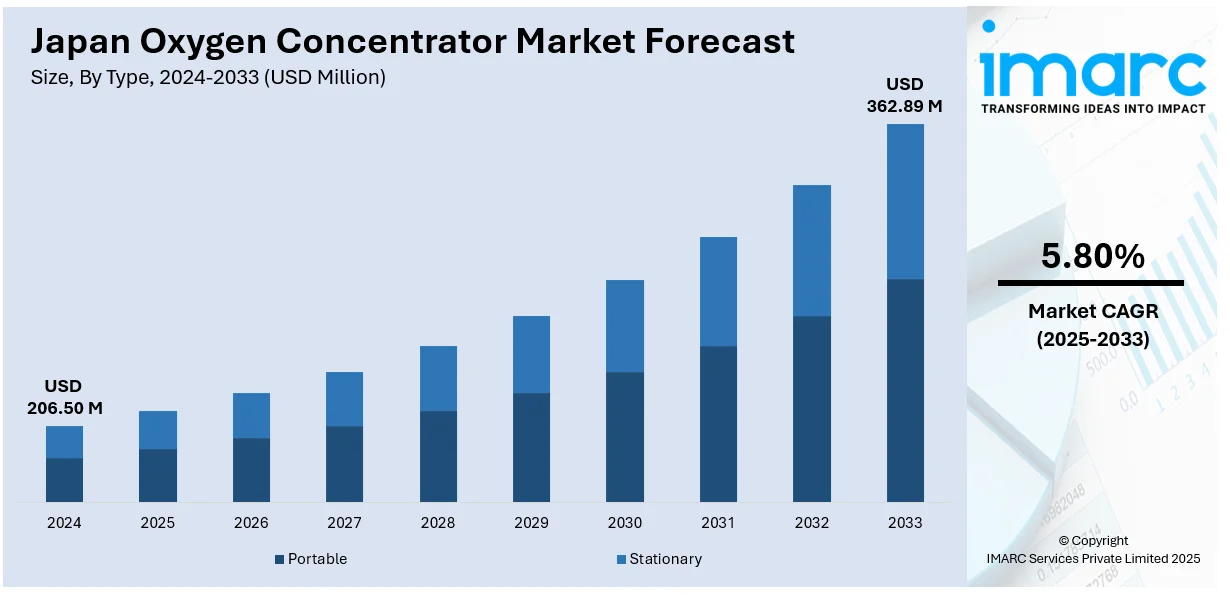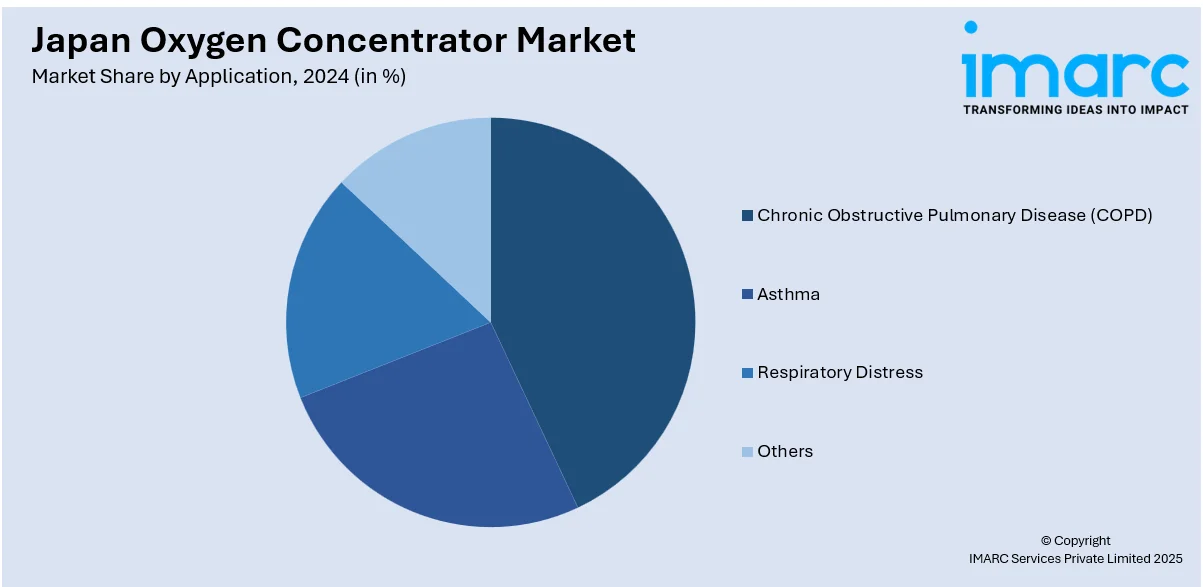
Japan Oxygen Concentrator Market Size, Share, Trends and Forecast by Type, Technology, Application, End User, and Region, 2025-2033
Japan Oxygen Concentrator Market Overview:
The Japan oxygen concentrator market size reached USD 206.50 Million in 2024. Looking forward, IMARC Group expects the market to reach USD 362.89 Million by 2033, exhibiting a growth rate (CAGR) of 5.80% during 2025-2033. The market is experiencing significant growth due to the prevailing aging population, rising respiratory diseases like COPD and asthma, and advancements in oxygen therapy technologies. The increasing preferences for home healthcare solutions, and government initiatives and improved healthcare infrastructure also contribute positively to the Japan oxygen concentrator market share.
|
Report Attribute
|
Key Statistics
|
|---|---|
|
Base Year
|
2024
|
|
Forecast Years
|
2025-2033
|
|
Historical Years
|
2019-2024
|
| Market Size in 2024 | USD 206.50 Million |
| Market Forecast in 2033 | USD 362.89 Million |
| Market Growth Rate 2025-2033 | 5.80% |
Japan Oxygen Concentrator Market Trends:
Increasing Geriatric Population
Japan's aging population is one of the key drivers of the demand for long-term oxygen therapy. According to Japan’s Ministry of Internal Affairs and Communications, Japan's elderly population reached a record 36.25 million, with individuals aged 65 and older comprising nearly 30% of the total population. This demographic shift poses challenges, as the nation faces a declining workforce and increasing healthcare costs. Projections suggest that this figure may rise to 34.8% by 2040. With the percentage of elderly people on the rise, the prevalence of age-related respiratory diseases like Chronic Obstructive Pulmonary Disease (COPD), emphysema, and pulmonary fibrosis also increases. These diseases tend to need continuous oxygen therapy to ensure adequate oxygen levels in the blood, particularly in the advanced stages. For older patients, home oxygen therapy is especially appealing since it provides convenience and comfort, enabling them to live with their condition without constant hospital visits. The demand for dependable, portable, and stationary oxygen concentrators is increasing as the aging population tries to lead an active life while undergoing necessary treatment. In addition, Japan's government and healthcare system increasingly emphasize offering access to home healthcare, further driving demand for oxygen concentrators and helping to drive the market.

Technological Advancements
Technological advancements are significantly shaping the Japan Oxygen Concentrator Market, with a focus on developing portable, energy-efficient, and user-friendly devices. The demand for portable oxygen concentrators has surged, especially for patients who prefer to continue their daily activities without being tethered to stationary units. These devices are now more compact, lightweight, and easy to use, offering enhanced mobility and comfort for users. Energy efficiency is another major focus, as newer models are designed to consume less power while delivering the same level of oxygen output, reducing operational costs for patients. Additionally, advancements in user interface design have made these concentrators more intuitive, with features like touchscreens, easy-to-read displays, and remote monitoring capabilities. These improvements make it easier for patients, particularly the elderly, to manage their condition at home while maintaining a better quality of life. Such innovations are driving the Japan oxygen concentrator market growth.
Shift to Home Healthcare Setting
The shift toward home healthcare in Japan is a key trend influencing the demand for oxygen concentrators. Patients, especially the elderly and those with chronic respiratory conditions like COPD and asthma, increasingly prefer home-based oxygen therapy over hospital stays. Home healthcare offers greater convenience, allowing patients to receive continuous treatment in the comfort of their own homes. This reduces the need for frequent hospital visits and minimizes disruptions to daily life. Oxygen concentrators provide a reliable solution for home-based care, enabling patients to manage their condition independently. Additionally, home oxygen therapy helps reduce healthcare costs by preventing long hospital admissions and promoting early intervention in case of exacerbations. With Japan’s healthcare system focusing on supporting elderly care and home healthcare services, the adoption of oxygen concentrators for home use is rising, leading to greater market growth and improved patient outcomes.
Japan Oxygen Concentrator Market Segmentation:
IMARC Group provides an analysis of the key trends in each segment of the market, along with forecasts at the country and regional levels for 2025-2033. Our report has categorized the market based on type, technology, application, and end user.
Type Insights:
- Portable
- Stationary
The report has provided a detailed breakup and analysis of the market based on the type. This includes portable and stationary.
Technology Insights:
- Continuous Flow
- Pulse Flow
A detailed breakup and analysis of the market based on the technology have also been provided in the report. This includes continuous flow and pulse flow.
Application Insights:

- Chronic Obstructive Pulmonary Disease (COPD)
- Asthma
- Respiratory Distress
- Others
A detailed breakup and analysis of the market based on the application have also been provided in the report. This includes chronic obstructive pulmonary disease (COPD), asthma, respiratory distress, and others.
End User Insights:
- Hospitals and Clinics
- Home Care Settings
- Ambulatory Surgical Centers and Physician Offices
A detailed breakup and analysis of the market based on the end user have also been provided in the report. This includes hospitals and clinics, home care settings, and ambulatory surgical centers and physician offices.
Regional Insights:
- Kanto Region
- Kansai/Kinki Region
- Central/Chubu Region
- Kyushu-Okinawa Region
- Tohoku Region
- Chugoku Region
- Hokkaido Region
- Shikoku Region
The report has also provided a comprehensive analysis of all the major regional markets, which include Kanto Region, Kansai/Kinki Region, Central/Chubu Region, Kyushu-Okinawa Region, Tohoku Region, Chugoku Region, Hokkaido Region, and Shikoku Region.
Competitive Landscape:
The market research report has also provided a comprehensive analysis of the competitive landscape. Competitive analysis such as market structure, key player positioning, top winning strategies, competitive dashboard, and company evaluation quadrant has been covered in the report. Also, detailed profiles of all major companies have been provided.
Japan Oxygen Concentrator Market Report Coverage:
| Report Features | Details |
|---|---|
| Base Year of the Analysis | 2024 |
| Historical Period | 2019-2024 |
| Forecast Period | 2025-2033 |
| Units | Million USD |
| Scope of the Report |
Exploration of Historical Trends and Market Outlook, Industry Catalysts and Challenges, Segment-Wise Historical and Future Market Assessment:
|
| Types Covered | Portable, Stationary |
| Technologies Covered | Continuous Flow, Pulse Flow |
| Applications Covered | Chronic Obstructive Pulmonary Disease (COPD), Asthma, Respiratory Distress, Others |
| End Users Covered | Hospitals and Clinics, Home Care Settings, Ambulatory Surgical Centers and Physician Offices |
| Regions Covered | Kanto Region, Kansai/Kinki Region, Central/Chubu Region, Kyushu-Okinawa Region, Tohoku Region, Chugoku Region, Hokkaido Region, Shikoku Region |
| Customization Scope | 10% Free Customization |
| Post-Sale Analyst Support | 10-12 Weeks |
| Delivery Format | PDF and Excel through Email (We can also provide the editable version of the report in PPT/Word format on special request) |
Key Questions Answered in This Report:
- How has the Japan oxygen concentrator market performed so far and how will it perform in the coming years?
- What is the breakup of the Japan oxygen concentrator market on the basis of type?
- What is the breakup of the Japan oxygen concentrator market on the basis of technology?
- What is the breakup of the Japan oxygen concentrator market on the basis of application?
- What is the breakup of the Japan oxygen concentrator market on the basis of end user?
- What is the breakup of the Japan oxygen concentrator market on the basis of region?
- What are the various stages in the value chain of the Japan oxygen concentrator market?
- What are the key driving factors and challenges in the Japan oxygen concentrator?
- What is the structure of the Japan oxygen concentrator market and who are the key players?
- What is the degree of competition in the Japan oxygen concentrator market?
Key Benefits for Stakeholders:
- IMARC’s industry report offers a comprehensive quantitative analysis of various market segments, historical and current market trends, market forecasts, and dynamics of the Japan oxygen concentrator market from 2019-2033.
- The research report provides the latest information on the market drivers, challenges, and opportunities in the Japan oxygen concentrator market.
- Porter's five forces analysis assist stakeholders in assessing the impact of new entrants, competitive rivalry, supplier power, buyer power, and the threat of substitution. It helps stakeholders to analyze the level of competition within the Japan oxygen concentrator industry and its attractiveness.
- Competitive landscape allows stakeholders to understand their competitive environment and provides an insight into the current positions of key players in the market.
Need more help?
- Speak to our experienced analysts for insights on the current market scenarios.
- Include additional segments and countries to customize the report as per your requirement.
- Gain an unparalleled competitive advantage in your domain by understanding how to utilize the report and positively impacting your operations and revenue.
- For further assistance, please connect with our analysts.
 Request Customization
Request Customization
 Speak to an Analyst
Speak to an Analyst
 Request Brochure
Request Brochure
 Inquire Before Buying
Inquire Before Buying




.webp)




.webp)












